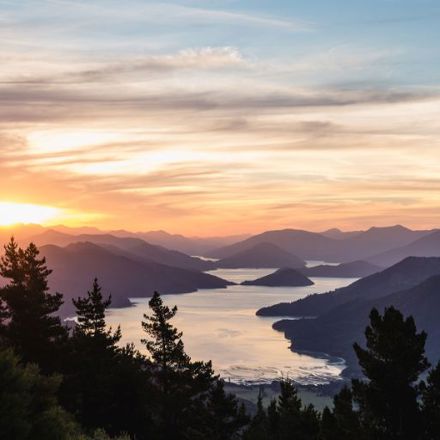The Marlborough Sounds
Early Maori spoke of two different legends of the formation of the Marlborough Sounds and New Zealand.
One tells how Kupe, the Maori warrior god, fought with a giant octupus in the Pacific Ocean. As the battle raged, the octupus reached out with its tentacles and grasped at nearby land, gouging out all the intricate bays and coves of the Marlborough Sounds. Kupe finally overcame and slew the octopus and cut out its eyes and threw them into the sea nearby - today these are the Brothers Islands near the entrance to Cook Strait.
The other speaks of Maori gods who came down from the heavens in a great canoe and then found themselves unable to return. The canoe capsized and its keel rose to form the Southern Alps while its prow shattered and sank, its ridges becoming the network of waterways known today as the Marlborough Sounds.
Geologists tell us the Marlborough Sounds are a network of sunken river valleys, where the land has slowly sunk and the water level has risen, flooding a vast area over millions of years. This intricate land mass is not only spectacular but unique in New Zealand as it is the only large land area that is still sinking into the sea. Three main bodies of water make up the Sounds - Queen Charlotte, Kenepuru and Pelorus - and a number of islands are dotted throughout its expanse.
Maori have inhabited New Zealand for more than 1000 years and it is believed that they have had a presence in this area since that time. Mobility was crucial during this early existence as settlement followed food source. There were many small settlements throughout the Marlborough Sounds and a number of different iwi (tribes) have affiliations to this place.
The first known European to visit Queen Charlotte Sounds was the famous English explorer, Captain James Cook, on the HMS Endeavour. He sailed into Ship Cove, today the start of the Queen Charlotte Track, on January 17, 1770 and made this small cove his South Pacific base for the next seven years. He was to return many times. It was here the first social interaction between South Island Maori and the European took place.
Today visitors to the Marlborough Sounds generally arrive by inter-island ferry from New Zealand's North Island into the charming seaside port of Picton, the gateway to Queen Charlotte Sound. The larger centre of Blenheim is also just 20 minutes drive away with a domestic airport and the coastal train from Christchurch also provides links by rail to and from Picton.
The Marlborough Sounds - it is the ultimate place to hike, mountain bike and sea kayak with Wilderness Guides as you follow in the footsteps of those gone before.








